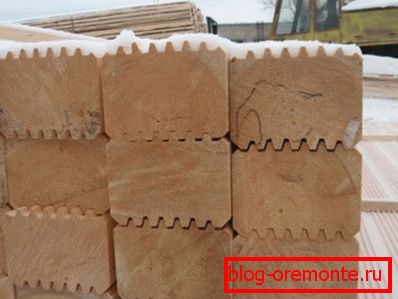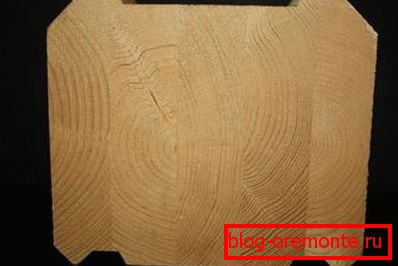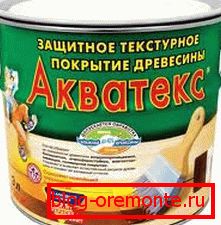Profile timber: a review of the material and its
Today, the construction of wooden houses is very often used profile comb comb, "Finnish" and timber with several teeth. What kind of material is it, how is it good and how is it different from laminated veneer lumber?
Let's try to understand everything in detail.

So, first of all, we will look at the difference between a profiled and glued timber.
Firstly, the name here speaks for itself. Glued laminated timber is made of planks (lamellas), pressed and glued together, and profiled is essentially a solid log.
Secondly, the glued laminated timber goes on sale already dried, and the profiled one dries out about a year after the completion of the house construction.
Thirdly, the heat-insulating qualities of glued laminated timber are slightly worse than that of a shaped analog. This is because the glued product has a layer of glue between the lamellae and this layer, by the way, tends to crack in some cases, which, of course, reduces the thermal insulation characteristics of the wall.

In general, at first glance it may seem that the glued products are better profiled, but there can not be such a hasty and unambiguous conclusion. On what kind of timber should be used, many factors inherent in a particular project affect. This is the desired price of materials (the profile tree is cheaper), and the climatic conditions of the territory where the object is located, and the purpose of the house.
Pay attention also to the fact that whoever made the material is of great importance. In addition, not least the role played by the professionalism of installers. Perhaps they have great experience in building houses from glued laminated timber, but they have never had to do anything from profile wood. If in such a situation to build a house from a profile bar, then most likely many mistakes will be made, and, you see, it will be somewhat illogical to “blame” for this. So what kind of timber to use depends only on the nuances of your particular situation.
We will return to the profile log view.
Material properties
First of all, it is worth highlighting the fact that this material has a slightly different structure, a way of connecting with each other, and this to some extent affects its properties.
This in particular is that the beam profiles are different.
For example, a timber with grooves of the “comb” type is a log, in the lower and upper plane of which there are many “teeth”. This is both bad and good.

It is good because there is no need for additional insulation tape between the logs, since due to the large number of teeth in the grooves, the possibility of passing cold air into the room is simply excluded.
And badly, because such material is much harder to fasten to each other. This is because after the delivery of logs to the object, they inevitably fall into the conditions of a drop in humidity and temperature, and accordingly lose their original shape.
That is, to put it simply, they are deformed and after that their teeth are very hard to insert into the grooves of neighboring logs without the use of a sledge hammer. And the use of a sledgehammer can lead to the appearance of cracks on the timber, which, of course, will reduce its insulating quality.
But on the other hand, if you do the comb, then it will be a very durable and warm house or cottages from a bar.
The second type of timber is the so-called “Finnish” profile. We can say that for the construction is the easiest and fastest option. Because there are only two thorns around the edges, and accordingly, the connection of such logs is a very fast process. In addition, the walls of this profile practically do not shrink.
However, there are, of course, a couple of negative points:
- In order to really connect such logs, you need not only to try hard, but also to really understand this matter and be able to work with this material.
- A house from a profile bar of this type will not have good thermal insulation qualities unless there is a special mezhventsovy insulation for the bar between the logs.
It turns out that it is quite possible to build residential houses from the “Finnish” profile, but it is very important not to forget about additional weatherization.

The third variant of the profile, which is often used when building houses from a profile bar, is a “three-four-toothed” beam. In fact, this is the most versatile profile view, as its spikes are wide enough not to deform during storage at the facility. That is, the material can be safely stored - to mount it will be quite easy.
As for the thermal insulation characteristics, as a rule, for a not very harsh climate, a few thorns of the Finnish profile are enough to block the path to frost and wind. But if you live in the northern regions, then, perhaps, it is better to still use the bar "comb".

As you can see, it is impossible to correctly determine what profile of a beam is 100% right - everything again depends on the nuances of the situation. It turns out that each type of material is good in its own way, but also has its drawbacks.
Tip: if you plan to build a house with your own hands, but you are not sure which kind of material is better to choose, then at least reinsure and consult with a professional about this. It will be inexpensive, but the risk of an erroneous choice will be minimized.
Well, we have dealt with the types of timber, now we proceed to the general review of material properties.
Benefits
So, we can highlight the following advantages of this material and houses from it:
- This is a 100% solid wood, which is based on such species as spruce, pine, Siberian larch or cedar. Wood processing is almost always performed on high-precision imported equipment. Due to this factor, the spikes are very tight in the grooves of adjacent logs, which, of course, gives the walls high strength and eliminates the need to purchase numerous fasteners;

- The structure of the profile beam does not contain any glue. This means that the strength of the product is not lost over time, and there will be no chemical fumes;
Please note that the lack of adhesive compositions also affects the indoor microclimate in the room - in a positive direction. Such houses from profiled timber, or rather their walls, “breathe” very well, so to speak, 100%, and all because their structure is completely natural and there are no artificial layers. So if you want your house to be not only warm in winter, but also cool in summer, then a house from a profile bar is really what you need. If everything is done correctly, then no air conditioners will be needed on a hot day!
- Thanks to the walls of the profile logs, significantly reduced the cost of heating in the winter period, it does not require any additional measures for insulation - hinged facades, "wet" and so on;
- No standard exterior and interior wall finish required. That is, the house will not need to plaster, putty, paint, glue wallpaper, etc. What for? After all, logs already have a magnificent appearance, agree;
- It is not necessary to treat the timber with antiseptics, because this procedure is performed at the factory. Moreover, the effect of this is greater than the application of an antiseptic with their own hands, since the process at the plant takes place in an autoclave. This allows you to cover the maximum structure of the tree, and because of this it does not spoil for a very long time;

- Relatively simple instruction for assembling walls from a profile bar. In fact, all that is required is to maximally correctly and accurately drive the thorns of each subsequent log into the grooves of the previous one.
As you can see, it turns out that this type of timber is a truly excellent material for building a house. Ecologically safe, really natural material which besides is convenient in assembly and durable. And the price for it is relatively low, what else is needed?
However, the flaws in the profile log, of course, also exist. And they definitely need to be mentioned.
Material disadvantages
In fact, only two shortcomings.
- The house of the profile bar must stand 10-12 months, and only then you can begin to finish it. That is, put interior doors, for example, putty ceilings are not recommended immediately after construction. Shrinkage is small, but it is. However, the house from which material is not subject to shrinkage? Therefore, it is very difficult to determine whether this moment should be considered a disadvantage.
- In the process of drying logs, they may appear cracks. As a rule, they are small, but then you have to close them up.

In principle, it can be noted that almost all projects of houses from a profile bar do not provide for the design of buildings in the style of high-tech, modern, etc. And this is understandable - after all, wood is wood, and such walls are suitable only for houses with a claim for environmental friendliness and naturalness.
So if you want to make a house in which stone or metal elements will prevail, then the profile log is clearly not the material that you need.

But in general, it turns out that the material has more advantages than disadvantages, so it is quite possible to use it.
Let's sum up.
Conclusion
We have looked at how the glued laminated timber differs from the profiled one, and also got acquainted with what types of profiles are. In addition, we figured out the features of these logs. If you want to know more, then in the presented video in this article you will find additional information on this topic.